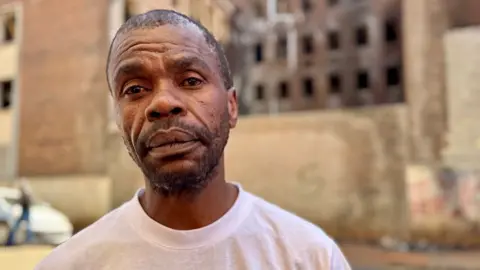Blackened by soot, the gutted and derelict remains of South Africa's infamous Usindiso building in central Johannesburg are an unintentional memorial to the 76 people who died here in a devastating fire two years ago.
At one time an office block, the 1950s building in the Marshalltown area was abandoned and then taken over by several hundred people desperately needing a home.
One of those was Vusi Tshabalala, who shakes his head in disbelief as he recalls how he survived the blaze on that late August night.
The fire seemed to come out of nowhere, the 45-year-old tells the BBC in a melancholic voice, raspy from years of smoking cigarettes.
Mr Tshabalala was asleep on the third floor of the five-storey building, where he was sharing a place with his then-girlfriend and brother.
Awoken by the flames, they managed to escape by covering themselves in wet blankets and running in the dark towards an exit at the rear.
As we were running others got injured, because when they fell down, they couldn't get back up. People were running over them. I thank God that we came out without any injuries.
The tragedy shocked the nation and highlighted the deep housing inequalities in Africa's wealthiest city - inequalities the authorities promised to address.
Visiting just hours after the blaze, President Cyril Ramaphosa called it a wake-up call to begin to address the situation of housing in the inner city.
But two years on, Mr Tshabalala and many others have still not found a permanent home.
Initially he was relocated to Rosettenville, 5km (three miles) south of Marshalltown, but he says he left because he could not find work around there.
Next he tried the industrial neighbourhood of Denver, 6km east of the Usindiso building, where other survivors have been placed - but says the frequent shootings forced him to leave.
At the moment he lives in the shadow of his former home, where other former Usindiso building residents have put up shacks in an informal settlement known as Emaxhoseni.
Made of corrugated iron and wood, the structures are tightly packed together - and a few feet away, some people have even set up makeshift tents against the wall of the Usindiso building.
The street is filthy and residents tell us the drainage is poor. During the summer rains, the area gets flooded and filled with waste.
But for Mr Tshabalala, who is currently working on a nearby construction site, living here is worth it: I came back because at least here we get jobs. The other places we were taken to, we can't find work.
He blames the authorities for not doing enough to support the survivors of the fire: No-one wants to know where the people from this tragedy are living.
Some of survivors have remained at a camp set up for them in Denver - though this does not mean they are happy.
This place is not safe, 29-year-old Thobeka Biyela tells the BBC.
Ms Biyela, who works as a police volunteer, explains how she was shot earlier this year. I heard gunshots. Then I was hit by a bullet. I don't know who shot me but some guys were fighting outside, she says, struggling to hold back the tears.
She is desperate to leave the camp but cannot afford private rent as her volunteering role pays her very little. If the government had relocated us after six months like they promised us, maybe I wouldn't blame them. But I blame them because it's been two years.
The camp residents say three people have been killed since their arrival in Denver: one stabbed, another beaten to death and the third shot. Many, including Tshabalala, remain skeptical about future improvements in their living conditions.



















